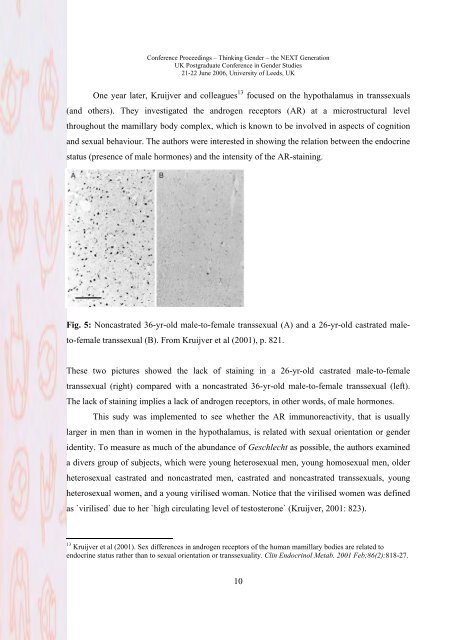On Geschlecht in Brain Science Experiments Anelis Kaiser LSE ...
On Geschlecht in Brain Science Experiments Anelis Kaiser LSE ...
On Geschlecht in Brain Science Experiments Anelis Kaiser LSE ...
Create successful ePaper yourself
Turn your PDF publications into a flip-book with our unique Google optimized e-Paper software.
Conference Proceed<strong>in</strong>gs – Th<strong>in</strong>k<strong>in</strong>g Gender – the NEXT Generation<br />
UK Postgraduate Conference <strong>in</strong> Gender Studies<br />
21-22 June 2006, University of Leeds, UK<br />
<strong>On</strong>e year later, Kruijver and colleagues 13 focused on the hypothalamus <strong>in</strong> transsexuals<br />
(and others). They <strong>in</strong>vestigated the androgen receptors (AR) at a microstructural level<br />
throughout the mamillary body complex, which is known to be <strong>in</strong>volved <strong>in</strong> aspects of cognition<br />
and sexual behaviour. The authors were <strong>in</strong>terested <strong>in</strong> show<strong>in</strong>g the relation between the endocr<strong>in</strong>e<br />
status (presence of male hormones) and the <strong>in</strong>tensity of the AR-sta<strong>in</strong><strong>in</strong>g.<br />
Fig. 5: Noncastrated 36-yr-old male-to-female transsexual (A) and a 26-yr-old castrated maleto-female<br />
transsexual (B). From Kruijver et al (2001), p. 821.<br />
These two pictures showed the lack of sta<strong>in</strong><strong>in</strong>g <strong>in</strong> a 26-yr-old castrated male-to-female<br />
transsexual (right) compared with a noncastrated 36-yr-old male-to-female transsexual (left).<br />
The lack of sta<strong>in</strong><strong>in</strong>g implies a lack of androgen receptors, <strong>in</strong> other words, of male hormones.<br />
This sudy was implemented to see whether the AR immunoreactivity, that is usually<br />
larger <strong>in</strong> men than <strong>in</strong> women <strong>in</strong> the hypothalamus, is related with sexual orientation or gender<br />
identity. To measure as much of the abundance of <strong>Geschlecht</strong> as possible, the authors exam<strong>in</strong>ed<br />
a divers group of subjects, which were young heterosexual men, young homosexual men, older<br />
heterosexual castrated and noncastrated men, castrated and noncastrated transsexuals, young<br />
heterosexual women, and a young virilised woman. Notice that the virilised women was def<strong>in</strong>ed<br />
as `virilised` due to her `high circulat<strong>in</strong>g level of testosterone` (Kruijver, 2001: 823).<br />
13 Kruijver et al (2001). Sex differences <strong>in</strong> androgen receptors of the human mamillary bodies are related to<br />
endocr<strong>in</strong>e status rather than to sexual orientation or transsexuality. Cl<strong>in</strong> Endocr<strong>in</strong>ol Metab. 2001 Feb;86(2):818-27.<br />
10


